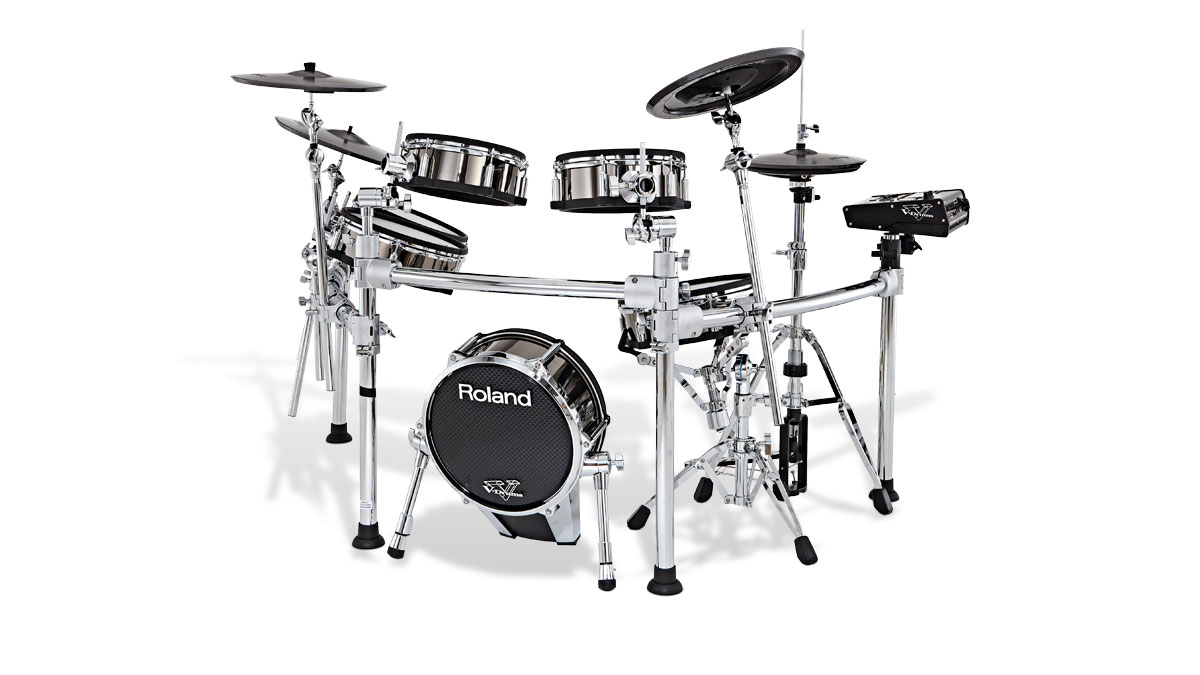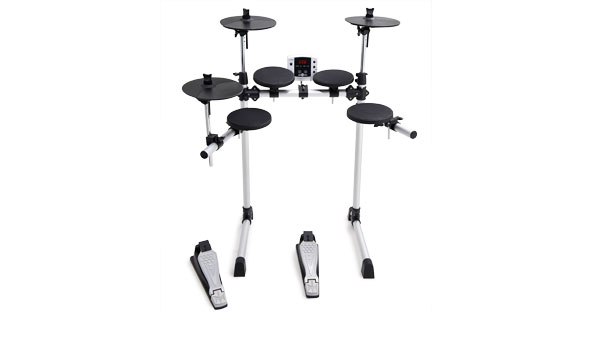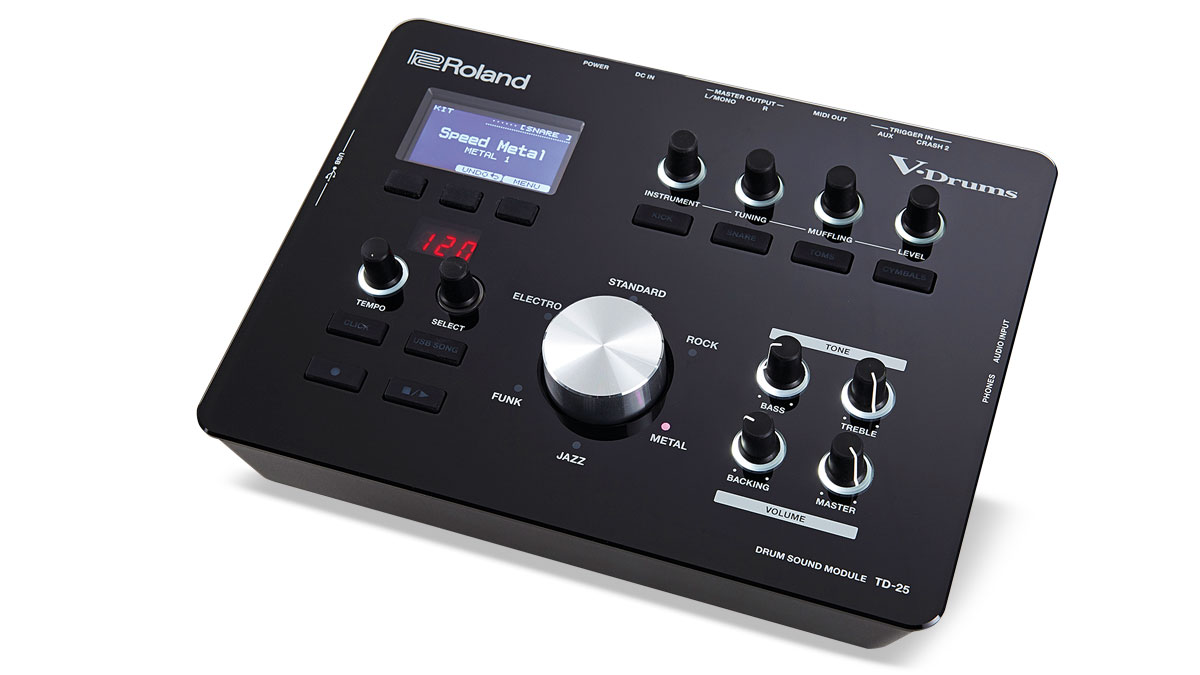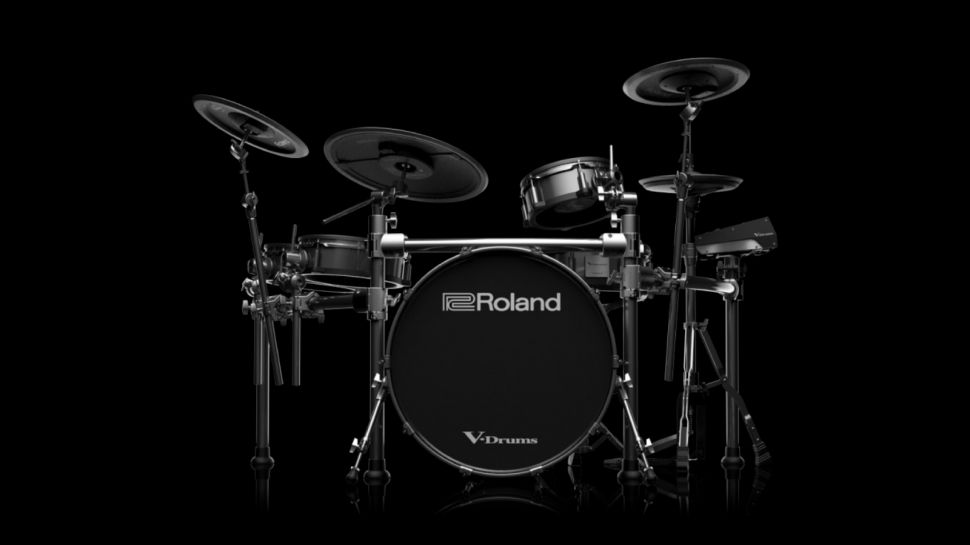MusicRadar Verdict
The TD-25 represents the highest quality, and quickest self-contained option in its class.
Pros
- +
Highly reactive playing surfaces and software. New TD-25 module looks great and is much more user-friendly. Good value.
Cons
- -
Metal sounds could be better.
MusicRadar's got your back

Roland TD-25KV

Rear

Module
In a world where a kettle is 'smarter' than your decade-old PC, a watch can send an email for you, and even your pets are getting in on the 'wearable tech' boom, it's easy to get carried away with technology. Roland has taken the opposite approach with its latest release, the TD-25 electronic drum set, by stripping back the design and layout of its module.
The basic principle is to supply the end user with fewer but better quality sounds, making it easier and more appealing to play. If you're a fan of multi-layered vibraslaps, or regularly gravitate towards samples of people going 'Yeeeeah!', prepare to have your dreams shattered...
Build
"Hang on, isn't this like when chocolate bars get smaller in the name of health, but the price stays the same?" We know what you're getting at, but here's the thing.
'Streamlined', 'simplified' and 'modernised' should not be confused with 'devoid of functionality'. The TD-25 is available in two configurations: TD-25KV and TD-25K. The first includes Roland's 10" PDX-100 snare pad and 10" floor tom pads, with a pair of PD-85 pads for the rack toms, plus you get a ride and two crash cymbals.
"Roland's plan here was to strip away the fat, and improve the quality of what is kept"
The TD-25K comes with the same snare pad, but uses the smaller PDX-6 and PDX-8 mesh pads on the rack and floor toms respectively, and you get one ride and one crash cymbal pad.
Both kits use the more 'proper' VH-11 hi-hat trigger, mountable to a real mechanical hi-hat stand, as well as the cloth-headed KD-9 bass drum pad, and both use the same TD-25 brain.
Inside the module are 18 kits, categorised by six different styles and making use of Roland's SuperNATURAL behaviour modelling. Trickled-down from the flagship TD-30, it aims to make the kit more adaptive to your playing, and more realistic sounding.
Want all the hottest music and gear news, reviews, deals, features and more, direct to your inbox? Sign up here.
Also on-board is an audio recording function, multi-effects and USB connectivity as well as the usual audio ins and outs. It's got everything Roland reckons you might need, and nothing that it thinks you won't.
Hands on
When we found out that Roland was redesigning the visuals for the TD-25, we secretly did a bit of a fist-bump. We were right to, because the glassy, clean layout of the TD-25 looks brilliant. So good, in fact, that even fairly recent modules look positively old-hat by comparison. Gone are the dust-collecting faders, replaced by 10 slick, illuminated rotaries, 11 soft-press switches and a brightly backlit screen.
If your only experience of using electronic drum modules is scrolling a tiny cursor through umpteen different settings, only to find you've gone past the one you want and have to start over again, you'll like the TD-25 from the off.
Thanks to the large grey rotary control in the middle of the module, there's no confusing what and where you need to be pressing to navigate your way through the kits.
The sounds are split into categories. 'Standard' offers studio-style kits that are fairly genre-agnostic, leaning towards the studio/pop side of things, while the other genres speak for themselves.
Among our favourite preset kits were Dry Funk for fat '70s backbeats, punchy kick drums and heavy-hats. Custom Maple gives you a fairly modern radio-rock sound, while Vintage is more in line with the deep-snared, weighty sound of classic rock.
The metal group was our least favourite, with some of the tom and snare sounds too over-processed, the most natural being the Speed Metal kit, with pointy bass drums and cutting snare and tom sounds.
"The addition of audio recording makes capturing ideas for songs much easier"
There is also a small selection of electronic kits, too, ranging from samples of the classic 909 to the 'Modern Swag' set. It's this group, which feels slightly lacking in variation, where you'll first start to notice the 'less-is-more' approach. It's not that these sounds are bad, just that the representing a larger cymbal or drum size.
Likewise, graphics for the instrument and muffling settings (open, gel, o-rings, etc) make everything nice and clear. It's a straightforward way of editing, which means you can do it 'on-the-fly', save it and continue doing what you really came here to do: play!
We mentioned earlier that Roland's plan here was to strip away the fat, and improve the quality of what is kept. A big part of this is the SuperNATURAL modelling. Roland isn't one to shy away from an acronym or branded technology.
Like COSM, it's Roland's catch-all term that appears across its product groups, however Roland says that SuperNATURAL is applied in different ways to each group, to capture the individual nuances of the manner in which an instrument reacts and responds to different ways of being played.
In the case of drums, it seems to be a mixture of a lot of sensors, a lot of samples and some clever switching. For example, playing a buzz roll on the snare drum doesn't just play back the same sample quietly, and repeatedly.
The sensors in the snare pad are able to detect stick positioning across the head, so, as with a real snare drum, you'll get a weightier sound with more 'snare' response towards the centre of the drum, and a thinner, less responsive sound towards the edge. It's there, it's noticeable, and it works!
Finally, there's the addition of audio recording and playback. Rather than doing this internally, you'll need a USB memory stick, which plugs into a dedicated port on the side of the brain. It makes capturing ideas for songs, recording a performance to a jam track - say, to accompany a YouTube video - or just playing along to your favourite tunes much easier.
Roland calls the TD-25 kits 'mid-level', and while this is true for its own range, it is a large chunk of change in the context of most set-ups. Right or wrong, there's still a massive stigma attached to gigging with electronic kits, and Roland is pushing this more as a home/studio tool - a very good one it is too.
But there's no getting away from the fact that specialised sample packs are available as affordable third-party upgrades for any e-kit. That said, not everyone wants to be, or can be, tethered to a computer when they play.
If you want to keep your technology confined to the kettle, and simply plug in and play in a responsive and realistic way, it's hard to beat.

Stuart has been working for guitar publications since 2008, beginning his career as Reviews Editor for Total Guitar before becoming Editor for six years. During this time, he and the team brought the magazine into the modern age with digital editions, a Youtube channel and the Apple chart-bothering Total Guitar Podcast. Stuart has also served as a freelance writer for Guitar World, Guitarist and MusicRadar reviewing hundreds of products spanning everything from acoustic guitars to valve amps, modelers and plugins. When not spouting his opinions on the best new gear, Stuart has been reminded on many occasions that the 'never meet your heroes' rule is entirely wrong, clocking-up interviews with the likes of Eddie Van Halen, Foo Fighters, Green Day and many, many more.
